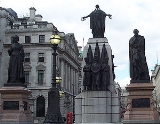
Crimean War Memorial
Encyclopedia
The Crimean War
Memorial is located on Waterloo Place, at the junction of Lower Regent Street
and Pall Mall
in London, about a quarter of the way from the Duke of York Column
to Piccadilly Circus
.
Originally it was unveiled in 1861, consisting of the statues of three Guards Men, with the female allegorical figure referred to as Honour. It was cast in bronze from the cannons captured at the siege of Sevastopol
. The sculptor was John Bell.
On the front, by the statues of the Guardsmen are two plaques.
The uppermost states:
The Lower one states:
On the back facade of the monuments, facing the road up to Piccadilly is another plaque, a shield surrounded by foliage and mounted on guns, this reads:
In 1914 it was pulled down and moved to make room for the statues of Florence Nightingale
and Sidney Herbert
- Secretary at War
at the War Office
during the War. It is only then that the allegorical figure is referred to as Victory. The sculpture of Florence Nightingale was by Arthur George Walker, and the sculpture of Sidney Herbert was by John Henry Foley
.
Crimean War
The Crimean War was a conflict fought between the Russian Empire and an alliance of the French Empire, the British Empire, the Ottoman Empire, and the Kingdom of Sardinia. The war was part of a long-running contest between the major European powers for influence over territories of the declining...
Memorial is located on Waterloo Place, at the junction of Lower Regent Street
Regent Street
Regent Street is one of the major shopping streets in London's West End, well known to tourists and Londoners alike, and famous for its Christmas illuminations...
and Pall Mall
Pall Mall, London
Pall Mall is a street in the City of Westminster, London, and parallel to The Mall, from St. James's Street across Waterloo Place to the Haymarket; while Pall Mall East continues into Trafalgar Square. The street is a major thoroughfare in the St James's area of London, and a section of the...
in London, about a quarter of the way from the Duke of York Column
Duke of York Column
The Duke of York Column is a monument in London, England, to Prince Frederick, Duke of York, the second eldest son of King George III. The designer was Benjamin Dean Wyatt. It is located near where Regent Street meets The Mall at Waterloo Place, in between the two terraces of Carlton House...
to Piccadilly Circus
Piccadilly Circus
Piccadilly Circus is a road junction and public space of London's West End in the City of Westminster, built in 1819 to connect Regent Street with the major shopping street of Piccadilly...
.
Originally it was unveiled in 1861, consisting of the statues of three Guards Men, with the female allegorical figure referred to as Honour. It was cast in bronze from the cannons captured at the siege of Sevastopol
Sevastopol
Sevastopol is a city on rights of administrative division of Ukraine, located on the Black Sea coast of the Crimea peninsula. It has a population of 342,451 . Sevastopol is the second largest port in Ukraine, after the Port of Odessa....
. The sculptor was John Bell.
On the front, by the statues of the Guardsmen are two plaques.
The uppermost states:
The Guards' Memorial was pulled down in the year of our lord 1914 and was re-erected 30 feet north in order to permit the erection of the Florence Nightingale and Sidney Herbert statues.
The Lower one states:
The foundation stone of the Guards' Memorial was laid in the year of our lord 1861 by Margaret Johanna Bell.
On the back facade of the monuments, facing the road up to Piccadilly is another plaque, a shield surrounded by foliage and mounted on guns, this reads:
To the memory of 2152 Officers, Non-Com. Officers and Privates of the BRIGADE OF GUARDS who fell during the war with Russian in 1854-56. Erected by their Comrades.
In 1914 it was pulled down and moved to make room for the statues of Florence Nightingale
Florence Nightingale
Florence Nightingale OM, RRC was a celebrated English nurse, writer and statistician. She came to prominence for her pioneering work in nursing during the Crimean War, where she tended to wounded soldiers. She was dubbed "The Lady with the Lamp" after her habit of making rounds at night...
and Sidney Herbert
Sidney Herbert, 1st Baron Herbert of Lea
Sidney Herbert, 1st Baron Herbert of Lea PC was an English statesman and a close ally and confidante of Florence Nightingale.-Early life:...
- Secretary at War
Secretary at War
The Secretary at War was a political position in the English and later British government, with some responsibility over the administration and organization of the Army, but not over military policy. The Secretary at War ran the War Office. It was occasionally a cabinet level position, although...
at the War Office
War Office
The War Office was a department of the British Government, responsible for the administration of the British Army between the 17th century and 1964, when its functions were transferred to the Ministry of Defence...
during the War. It is only then that the allegorical figure is referred to as Victory. The sculpture of Florence Nightingale was by Arthur George Walker, and the sculpture of Sidney Herbert was by John Henry Foley
John Henry Foley
John Henry Foley , often referred to as JH Foley, was an Irish sculptor, best known for his statues of Daniel O'Connell in Dublin, and of Prince Albert in London. Both are still considered iconic in each city.-Life:...
.

